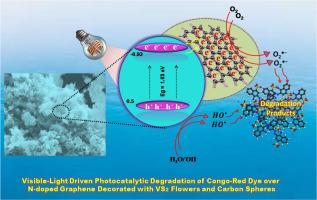Harnessing advanced interfaces in ternary photocatalysts: VS₂ nanoflowers with carbon spheres and N-doped graphene for wastewater treatment
IF 6.3
2区 材料科学
Q2 CHEMISTRY, PHYSICAL
引用次数: 0
Abstract
A simple hydrothermal technique was employed to prepare vanadium sulfide flowers (VS2) and carbon spheres (Cs). Their binary composite (VS/Cs) and ternary composite with nitrogen-doped graphene (VS/Cs/NG) were synthesized via ultrasonication. The as-fabricated photocatalysts (VS2, VS/Cs, and VS/Cs/NG) were scrutinized for the photodegradation of actual wastewater containing Congo red (CR) dye. The phase detection, morphological analysis, and structural features were determined by XRD, FTIR, SEM, PL, XPS, and UV/VIS analysis. XRD results attributed the monoclinic crystal phase to the C2 space group of VS2. SEM micrographs attributed the homogeneous stacked sheets of VS2, which are well arranged into flower-like 3D structure. The VS/Cs/NG composite showed the best photodegradation results for CR dye under visible light irradiation with a rate constant of 0.02387 min−1. Notably, the experimental results ascribed a noteworthy impact of reaction media on the photodegradation of the pollutant, recommending that pH 3 and 20 mg photocatalyst dosage are favorable conditions for this photocatalytic reaction mechanism. In conclusion, this study illustrates that the VS/Cs/NG composite can serve as a competent photocatalyst for the photodegradation of actual wastewater.

利用先进的三元光催化剂界面:碳球VS纳米花和n掺杂石墨烯用于废水处理
采用简单的水热法制备了硫化钒花(VS2)和碳球(Cs)。通过超声波合成了它们的二元复合材料(VS/Cs)和掺氮石墨烯三元复合材料(VS/Cs/NG)。研究了制备的光催化剂(VS2、VS/Cs和VS/Cs/NG)对含有刚果红染料的实际废水的光降解效果。采用XRD、FTIR、SEM、PL、XPS、UV/VIS等分析手段对其进行相检、形貌分析和结构表征。XRD结果表明,单斜晶相为VS2的C2空间群。SEM显微图归因于均匀堆叠的VS2片,其排列良好,呈花状三维结构。VS/Cs/NG复合材料在可见光下对CR染料的降解效果最好,降解速率常数为0.02387 min−1。值得注意的是,实验结果表明反应介质对污染物的光降解有明显的影响,表明pH 3和20mg的光催化剂用量是实现该光催化反应机制的有利条件。综上所述,本研究表明VS/Cs/NG复合材料可以作为光催化剂用于实际废水的光降解。
本文章由计算机程序翻译,如有差异,请以英文原文为准。
求助全文
约1分钟内获得全文
求助全文
来源期刊

Surfaces and Interfaces
Chemistry-General Chemistry
CiteScore
8.50
自引率
6.50%
发文量
753
审稿时长
35 days
期刊介绍:
The aim of the journal is to provide a respectful outlet for ''sound science'' papers in all research areas on surfaces and interfaces. We define sound science papers as papers that describe new and well-executed research, but that do not necessarily provide brand new insights or are merely a description of research results.
Surfaces and Interfaces publishes research papers in all fields of surface science which may not always find the right home on first submission to our Elsevier sister journals (Applied Surface, Surface and Coatings Technology, Thin Solid Films)
 求助内容:
求助内容: 应助结果提醒方式:
应助结果提醒方式:


